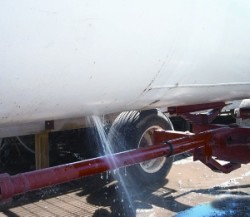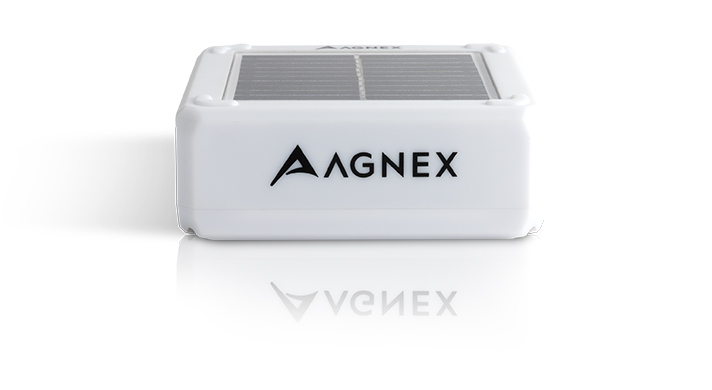Nurse Tank Testing Update
 Late last year the U.S. Department of Transportation (DOT) asked that an effort be made by the ag industry to get the word out on the importance of testing of non-data plate anhydrous/nurse tanks. As a DOT cargo tank inspector, I have been involved from the inception of this program.
Late last year the U.S. Department of Transportation (DOT) asked that an effort be made by the ag industry to get the word out on the importance of testing of non-data plate anhydrous/nurse tanks. As a DOT cargo tank inspector, I have been involved from the inception of this program.
The original request for an exemption came from The Fertilizer Institute (TFI) after DOT’s enforcement of several nurse tanks near Washington, DC, without legible data plates. These tanks were disallowed from further service because they were not in compliance. After several surveys, the industry discovered that as many as one-third of the tanks currently in use were without legible data plates.
Consequently, a committee was assembled by TFI and an exemption was requested and approved to continue the use of these tanks. The Nurse Tank Inspection Program (NTIP) requires visual, thickness, and pressure tests.
For this article, I will address this issue from four different perspectives:
â– DOT’s recent concerns.
â– TFI’s important contribution.
â– Schoettmer Enterprises Inc.’s tank testing experience.
â– Southern States Cooperative’s results.
DOT Concerns
This is an excerpt from a letter sent from R. Ryan Posten, director of the Office of Hazardous Materials Enforcement:
“To all anhydrous ammonia/nurse tank owners, fillers, transporters, repair stations, welders, inspectors and related associations:
Based on eight recent enforcement investigations conducted by the U.S. DOT, Pipeline and Hazardous Materials Safety Administration (PHMSA), Office of Hazardous Materials Enforcement (OHME), this letter is intended to notify the industry of serious safety problems and non-compliance issues regarding the maintenance, filling, transport, and use of nurse tanks in anhydrous ammonia service. PHMSA is greatly concerned with the lack of compliance and understanding of the minimum safety requirements for nurse tanks based on its investigations. PHMSA recognizes the breadth of the nurse tank industry. In order to magnify its safety and compliance efforts, PHMSA feels this letter will help increase awareness and provide a means of contact for questions about the prescribed safety requirements.
In all of the investigations, PHMSA Hazmat investigators noted a similar pattern of non-compliance and safety problems.”
TFI Involvement
In 2004, TFI applied to PHMSA, and was granted a special permit for nurse tanks without the required ASME identification plate to remain in transportation so long as certain tests were performed and passed. Those tests, contained in SP-13554, are an external visual test, a pressure test, and a thickness test. All tests must be conducted every five years.
Nurse tank owners and operators in the fertilizer industry take seriously anhydrous ammonia safety and comply with all applicable hazardous materials regulations pertaining to the transportation of anhydrous ammonia. Since the issuance of the special permit, more than 12,000 nurse tanks with missing or illegible identification plates have been tested with over 300 taken out of service for failure of one or more of the required tests. TFI has established an industry Web-based program to register tanks and maintain inspection reports. This program is administered by the Asmark Institute in Owensboro, KY.
Schoettmer’s Tank Testing Experience
To date, Schoettmer Enterprises has tested more than 1,400 tanks. All ag retailers want to be compliant with anhydrous ammonia hazardous materials regulations. Upon understanding the safety value of this testing, some retailers want to test all of their nurse tanks, not just the tanks required under the exemption.
The visual test looks for obvious problems such as dents, deep gouges, and welds that were obviously performed by non r-stamp welders.
The thickness test gets actual metal thickness in 32 different locations on tanks. As I have performed these inspections, as a rule, the older tanks were constructed with thicker metal. The tanks built in the last few years are thinner, and a gouge is more likely to put them out of service. However, if they have a good data plate, gouges can be repaired.
The most important test performed on nurse tanks is the pressure test. After completely filling them with water, 375 pounds of water pressure is applied to the tank for 10 minutes. On the inspections I have performed, several tanks have sprayed water out of weld seams in various locations of the tank. Other tank inspectors have reported a complete failure of a weld with the tank emptying all of its water. These are the tanks that could have caused personal injury. Thankfully, with water testing procedures, nobody gets hurt. Two out of 1,000 tanks I have tested failed the pressure test.
During the three tests performed, non-working pressure gauges, leaking site gauges, and a relatively high number of non-working excess flow valves are the most common areas of concern.
My experiences with retailers show their understanding and commitment to keeping valuable industry tools available in the future. Initially there may be skepticism as to the necessity of testing tanks; upon leaving, the employees at the testing locations clearly have a renewed appreciation for safety within the industry. I leave these locations with a shared sense of accomplishment.
Southern States’ Experience
Jordan Pigman, safety coordinator with Southern States Cooperative Inc., says: “Nothing is more important than the safety of our employees, farmers, and the communities we serve. At Southern States Cooperative, our ammonia facilities follow a detailed nurse tank inspection guideline to ensure tank safety and compliance with industry regulations. And we constantly search for methods to improve.
“After learning about the NTIP and working with Cliff Schoettmer, it validated the methods used and made sure the integrity and safety of nurse tanks was and is followed,” he says.





